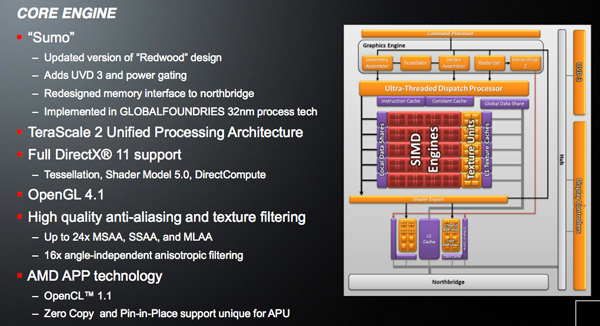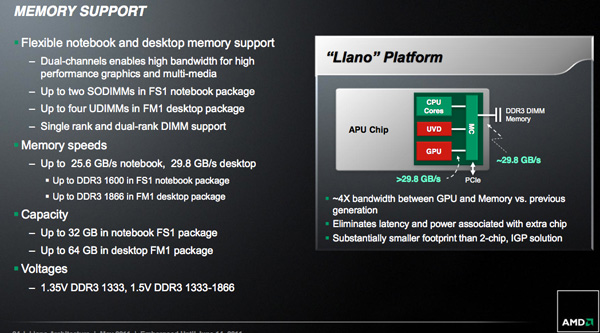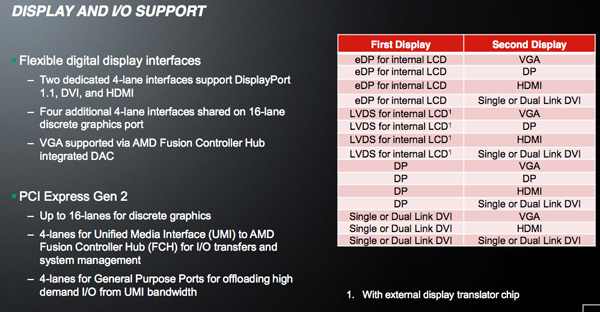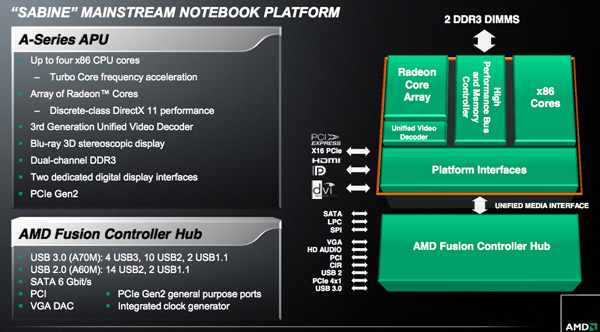The AMD Llano Notebook Review: Competing in the Mobile Market
by Jarred Walton & Anand Lal Shimpi on June 14, 2011 12:01 AM ESTThe GPU
While the Llano CPU cores may be in need of a major overhaul, Llano's GPU is as new as it gets. Technically based off of AMD's Redwood core (Radeon HD 5570) with some enhancements, Llano's GPU is codenamed Sumo.
The DX11 GPU features five SIMD arrays, each with 80 cores for a total of 400 shader processors. Similar to the updates we saw with this year's Northern Islands GPUs, Sumo does add UVD3 support to the Redwood architecture. Of course since Sumo shares the same die as the Llano CPU cores it is built on GlobalFoundries' 32nm process, making this the first AMD GPU fabbed at GlobalFoundries and not TSMC.
For everything behind the memory controller Sumo is virtually identical to Redwood. Where Sumo differs is in its memory interface. Although Llano is AMD's first performance oriented APU, it's still constrained by a 128-bit wide DDR3 memory interface. That dual-channel memory interface has to be shared by all four Llano cores as well as the Sumo GPU and as a result, arbitration is very important.
AMD shared a few choice details about the Llano memory controller architecture. To begin, AMD guarantees more than 30GB/s of bandwidth is available between the GPU and the memory controller—in other words, the path from GPU to the memory controller won't become a bottleneck. The GPU/memory controller link (i.e. within the APU die) can apparently scale up to as much as 50GB/s to support future APUs with even faster memory interfaces. Note that unlike previous integrated graphics solutions, there is no support for dedicated external memory—this is a pure shared memory architecture.
Second, and most importantly, AMD can dynamically prioritize memory bandwidth between the CPU and GPU. In most cases, when both processors are heavily consuming data, the GPU is given priority over the CPU. Given today's workloads, prioritizing the GPU for memory accesses makes sense when it's running full tilt. The chances of you stressing all four CPU cores and running at full GPU memory bandwidth requirements are pretty slim today.
With 400 shader processors behind a shared 128-bit DDR3 memory interface, the upper bound for Sumo performance is the Radeon HD 5570. In practice, you should expect performance to be noticeably lower since the GPU does have to share its precious memory bandwidth with up to four x86 CPU cores.
The mobile version of Llano supports up to DDR3-1600 while the desktop parts can run at up to DDR3-1866. Maximum memory capacities are 32GB and 64GB for notebooks and desktops, respectively.
Llano has a total of 24 PCIe Gen 2 lanes at its disposal. Sixteen of those lanes can be used for external graphics. Four of the lanes can be used for devices that need low latency/high bandwidth access to the APU itself (e.g. Gigabit ethernet). The remaining four lanes are used to connect the APU to its sole partner in crime: the Fusion Controller Hub.
AMD is particularly proud of the display output configurations supported by Llano. The possible combinations are listed below:
Chipsets
AMD will offer two Fusion Controller Hubs (FCHs) as options for Llano: A70M and A60M. The only difference between the two is in their support for USB 3.0; the A70M has four USB 3.0 ports while the A60M has none.
Both FCHs support 6Gbps SATA and perform just as well as AMD's 8-series chipset (or Intel's Z68) with a high performance SSD. USB 3.0 performance is also comparable to 3rd party solutions we've seen deployed on motherboards already.















177 Comments
View All Comments
ET - Wednesday, June 15, 2011 - link
It may be impossible to know the exact speed the cores run, but it would be interesting to run a test to get some relative numbers.You can run a single threaded CPU bound program such as SuperPI, then run it again with the other three cores at 100% (for example by having another three instances of SuperPI running). Do this on AC and battery, and it might generate some interesting numbers. At the very least we'll be able to tell whether the 1.5GHz -> 2.4GHz ratio looks right.
ET - Wednesday, June 15, 2011 - link
By the way, I just read Tom's Hardware review, which was unique in that it compared to a Phenom II X4 running at 1.5GHz and 2.4GHz. It looked from these benchmarks like the A8-3500M is always performing around the 1.5GHz level of the Phenom II X4 (sometimes it's a little faster, sometimes a little slower), which suggests that Turbo Core doesn't really kick in.i_am_the_avenger - Wednesday, June 15, 2011 - link
Maybe this will cheer the AMD Fans a bitThis article did not mention some nifty features the APUs have (or maybe it did I did not read it line by line)...................................
Watch the video below from engadget:
http://www.engadget.com/2011/06/13/amds-fusion-a-s...
It shows how these APUs can smooth out shaking videos real time, even while streaming from Youtube! and it does a very good job.
Another feature is how it en-chances videos (colour etc.)
This improves general user PC experience.......... something very desirable
The video also shows how AMD wants to target general users and not work enthusiasts
Another video shows comparison between the i7-2630QM and A8-3500M while multitasking video related applications.
http://www.engadget.com/2011/03/01/amd-compares-up...
---Interesting to note that the APU Gradually increased its power consumption while i7 was like bursting to and fro, something the way turbo core acts maybe-----
I think it is work vs general performance,
Intel's great for work, when you need to finish tasks and it needs to be done quickly,
while AMD APUs give you a good over all pc and multimedia performance - you watch videos, play games, so what if the zip file extracts a minute late and the fGPU performance is great....
You may buy a i7 SNB with discreate GPU but that has a battery life hit (for same battery capacity) and also extra heat generation which requires more fans, also the extra weight..
Please don't start judging me or something....
I am getting confused myself, while intel looks great in every way except stock gaming and battery life(not that bad)... I think I don't need that much power, even if I work - my work isn't so CPU oriented that an i7 would matter, a 30 second task finishes in 20 ok but it does not matter to me..... but improved video and battery seems more useful to me
I don't think that all of us have to tax our CPUs to full potential -- a few have to, not considering them -- so even if Intel have faster processors for many it does not affect them as much.
psychobriggsy - Wednesday, June 15, 2011 - link
For all your moaning about not getting Asymmetric CrossFire to work, you didn't read the reviewers guide that says it only works in DX10 and DX11 mode, not DX9. So your Dirt2 benches for example clearly state DX9 for this test. I don't know about the other titles on that page - you say 5 of the others are DX9 titles. Do these titles have DX10 modes of operation - if so, USE THEM.Otherwise it just looks like you are trying to get the best results for the Intel Integrated Graphics.
Just put "0 - Unsupported" for DX11 tests by HD3000 like other sites have done.
ET - Wednesday, June 15, 2011 - link
The article said:"AMD told us in an email on Monday (after all of our testing was already complete) that the current ACF implementation on our test notebook and with the test drivers only works on DX10/11 games. It's not clear if this will be the intention for future ACF enabled laptops or if this is specific to our review sample. Even at our "High" settings, five of our ten titles are DX9 games (DiRT 2, L4D2, Mafia II, Mass Effect 2, and StarCraft II--lots of twos in there, I know!), so they shouldn't show any improvement...and they don't. Actually, the five DX9 games even show reduced performance relative to the dGPU, so not only does ACF not help but it hinders. That's the bad news. The only good news is that the other half of the games show moderate performance increases over the dGPU."
I agree that at least in the case of DiRT 2 that's blatantly false, since that game was one of the first to use DX11, and was given with many Radeon 58x0 cards for this reason.
JarredWalton - Friday, June 17, 2011 - link
DiRT 2 supports DX11, but it's only DX9 or DX11. We chose to standardize on DX9 for our Low/Med/High settings -- and actually, DX11 runs slower at the High settings than DX9 does (though perhaps it looks slightly better). Anyway, we do test DiRT 2 with DX11 for our "Ultra" settings, but Llano isn't fast enough to handle 1080p with 4xAA and DX11. So to be clear, I'm not saying DiRT 2 isn't DX11; I'm saying that the settings we standardized on over a year ago are not DX11.jitttaaa - Wednesday, June 15, 2011 - link
How is the notebook llano performing as good, if not better than the desktop llano?ET - Wednesday, June 15, 2011 - link
At least as far as CPU power is concerned, the desktop part is obviously faster. The benchmarks are mostly not compatible so it's hard to judge, but in Cinebench R10 the mobile Llano gets 2037 while the desktop gets 3390. I agree that for graphics it looks like the desktop part is performing worse in games, which is strange considering the GPU is working at a faster speed.Only explanation I can think of is that the faster CPU is taking too much memory bandwidth, but it doesn't make much sense since it's been said that the GPU gets priority. It's definitely something that's worth checking out with AMD.
ionave - Thursday, June 16, 2011 - link
http://www.anandtech.com/show/4448/amd-llano-deskt...On average the A8-3850 is 58% faster than the Core i5 2500K.
Boom. Delivered. You think its slow? It really isn't. The A8-3850 has about the performance of a DESKTOP i3. If you think that is bad performance, then you don't know what you are talking about. The battery life is amazing for having that kind of performance in a laptop. I'm sorry, but it totally destroys i7 and i5 platforms because of the sheer performance in that amazing battery life.
JarredWalton - Friday, June 17, 2011 - link
Let me correct that for you:On average, the A8-3850 fGPU (6550D) is 58% faster than the Core i5-2500K's HD 3000 IGP, in games running at low quality settings. It is also 29% faster than the i5-2500K with a discrete HD 5450, which is a $25 graphics card. On the other hand, the i5-2500K with an HD 5570 (a $50 GPU) is on average 66% faster than the A8-3850.
Boom. Delivered. You think that's fast? It really isn't. The 6550D has about the performance of a $35 desktop GPU. If you think that is good performance, then you don't know what you are talking about.
At least Llano is decent for laptops, but for $650 you can already get i3-2310M with a GT 520M and Optimus. Let me spell it out for you: better performance on the CPU, similar or better performance on the GPU, and a price online that's already $50 below the suggested target of the A8-3500M. Realistically, A8-3500M will need to sell for $600 to be viable, A6 for $500, and A4 for $450 or less.